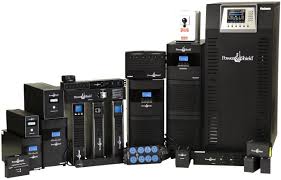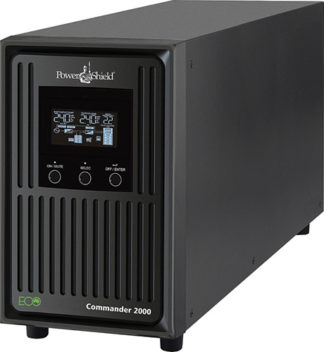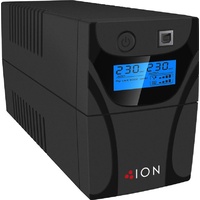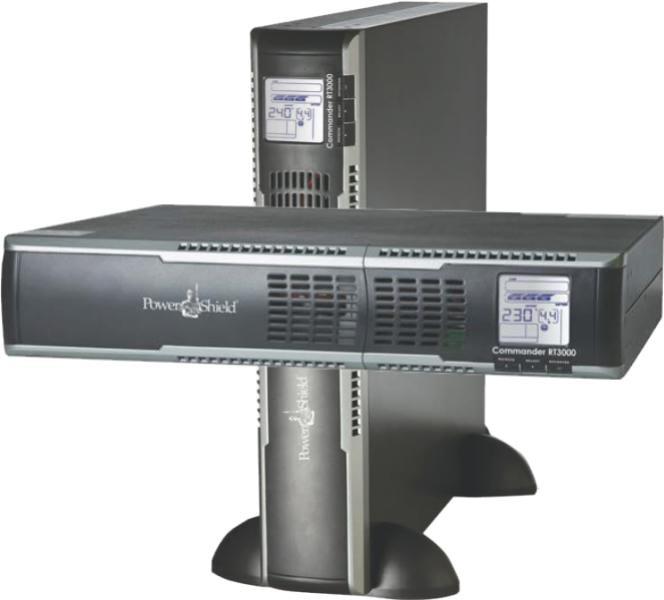Uninterruptible power supply
An uninterruptible power supply or uninterruptible power source (UPS) is an electrical apparatus that provides emergency power to a load when the input power source or mains power fails. A UPS differs from an auxiliary or emergency power system or standby generator in that it will provide near-instantaneous protection from input power interruptions, by supplying energy stored in batteries, supercapacitors.

A UPS is typically used to protect hardware such as computers, data centers, telecommunication equipment or other electrical equipment where an unexpected power disruption could cause injuries, fatalities, serious business disruption or data loss.
Technologies
The three general categories of modern UPS systems are on-line, line-interactive and standby:
An c uses a "double conversion" method of accepting AC input, rectifying to DC for passing through the rechargeable battery (or battery strings), then inverting back to 120 V/230 V AC for powering the protected equipment.

A line-interactive UPS maintains the inverter in line and redirects the battery's DC current path from the normal charging mode to supplying current when power is lost.

In a standby ("off-line") system the load is powered directly by the input power and the backup power circuitry is only invoked when the utility power fails.
Most UPS below one kilovolt-ampere (1 kVA) are of the line-interactive or standby variety which are usually less expensive.
For large power units, dynamic uninterruptible power supplies (DUPS) are sometimes used. A synchronous motor/alternator is connected on the mains via a choke. Energy is stored in a flywheel. When the mains power fails, an eddy-current regulation maintains the power on the load as long as the flywheel's energy is not exhausted. DUPS are sometimes combined or integrated with a diesel generator that is turned on after a brief delay, forming a diesel rotary uninterruptible power supply (DRUPS).
A fuel cell UPS was developed by the company Hydrogenics using hydrogen and a fuel cell as a power source, potentially providing long run times in a small space.
Offline/standby
The offline/standby UPS offers only the most basic features, providing surge protection and battery backup. The protected equipment is normally connected directly to incoming utility power. When the incoming voltage falls below or rises above a predetermined level the UPS turns on its internal DC-AC inverter circuitry, which is powered from an internal storage battery. The UPS then mechanically switches the connected equipment on to its DC-AC inverter output. The switch-over time can be as long as 25 milliseconds depending on the amount of time it takes the standby UPS to detect the lost utility voltage. The UPS will be designed to power certain equipment, such as a personal computer, without any objectionable dip or brownout to that device.

Line-interactive
The line-interactive UPS is similar in operation to a standby UPS, but with the addition of a multi-tap variable-voltage autotransformer. This is a special type of transformer that can add or subtract powered coils of wire, thereby increasing or decreasing the magnetic field and the output voltage of the transformer. This may also be performed by a buck–boost transformer which is distinct from an autotransformer, since the former may be wired to provide galvanic isolation.
This type of UPS is able to tolerate continuous undervoltage brownouts and overvoltage surges without consuming the limited reserve battery power. It instead compensates by automatically selecting different power taps on the autotransformer. Depending on the design, changing the autotransformer tap can cause a very brief output power disruption,[6] which may cause UPSs equipped with a power-loss alarm to "chirp" for a moment.
This has become popular even in the cheapest UPSes because it takes advantage of components already included. The main 50/60 Hz transformer used to convert between line voltage and battery voltage needs to provide two slightly different turns ratios: One to convert the battery output voltage (typically a multiple of 12 V) to line voltage, and a second one to convert the line voltage to a slightly higher battery charging voltage (such as a multiple of 14 V). The difference between the two voltages is because charging a battery requires a delta voltage (up to 13–14 V for charging a 12 V battery). Furthermore, it is easier to do the switching on the line-voltage side of the transformer because of the lower currents on that side.
To gain the buck/boost feature, all that is required is two separate switches so that the AC input can be connected to one of the two primary taps, while the load is connected to the other, thus using the main transformer's primary windings as an autotransformer. The battery can still be charged while "bucking" an overvoltage, but while "boosting" an undervoltage, the transformer output is too low to charge the batteries.
Autotransformers can be engineered to cover a wide range of varying input voltages, but this requires more taps and increases complexity, as well as the expense of the UPS. It is common for the autotransformer to cover a range only from about 90 V to 140 V for 120 V power, and then switch to battery if the voltage goes much higher or lower than that range.
In low-voltage conditions the UPS will use more current than normal, so it may need a higher current circuit than a normal device. For example, to power a 1000-W device at 120 V, the UPS will draw 8.33 A. If a brownout occurs and the voltage drops to 100 V, the UPS will draw 10 A to compensate. This also works in reverse, so that in an overvoltage condition, the UPS will need less current.

Online/double-conversion
In an online UPS, the batteries are always connected to the inverter, so that no power transfer switches are necessary. When power loss occurs, the rectifier simply drops out of the circuit and the batteries keep the power steady and unchanged. When power is restored, the rectifier resumes carrying most of the load and begins charging the batteries, though the charging current may be limited to prevent the high-power rectifier from overheating the batteries and boiling off the electrolyte. The main advantage of an on-line UPS is its ability to provide an "electrical firewall" between the incoming utility power and sensitive electronic equipment.
The online UPS is ideal for environments where electrical isolation is necessary or for equipment that is very sensitive to power fluctuations.[7] Although it was at one time reserved for very large installations of 10 kW or more, advances in technology have now permitted it to be available as a common consumer device, supplying 500 W or less. The online UPS may be necessary when the power environment is "noisy", when utility power sags, outages and other anomalies are frequent, when protection of sensitive IT equipment loads is required, or when operation from an extended-run backup generator is necessary.
The basic technology of the online UPS is the same as in a standby or line-interactive UPS. However it typically costs much more, due to it having a much greater current AC-to-DC battery-charger/rectifier, and with the rectifier and inverter designed to run continuously with improved cooling systems. It is called a double-conversion UPS due to the rectifier directly driving the inverter, even when powered from normal AC current.
Online UPS typically has a static transfer switch (STS) for increasing reliability.

